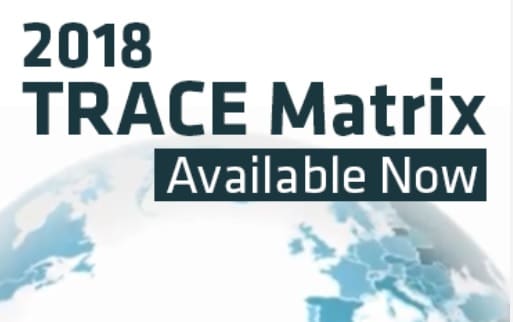Annapolis, MD (December 6, 2018) – TRACE International, the world’s leading anti-bribery standard setting organization, has released a new edition of the TRACE Bribery Risk Matrix (TRACE Matrix), a global business bribery risk assessment tool. With this new edition, TRACE has also launched the TRACE Matrix Data Browser, an online tool allowing users to sort and group the data from which the Matrix scores are derived and identify trends and patterns that may be relevant in understanding the risk environment each country presents.
This year’s TRACE Matrix country rankings are largely in keeping with previous results. As before, New Zealand, Sweden, Norway, Denmark and Finland rank among the least risky countries, while Somalia, Libya, Venezuela, Chad and Turkmenistan appear among the worst.
The TRACE Matrix was originally published in 2014 to meet a need in the business community for more reliable, nuanced information about the risk of commercial bribery worldwide. It addresses the risk that companies will be asked for bribes within each country, rather than the conduct of the companies or citizens. Publicly available at no cost, the TRACE Matrix helps companies examine the conditions that allow commercial bribery to flourish:
- the nature and extent of government interaction with the private sector,
- societal attitudes toward bribery and the government’s ability to enforce its prohibition,
- the degree of governmental transparency and
- the ability of civil society to monitor and expose corruption.
For each of these four “domains” (and related subdomains), the TRACE Matrix aggregates data obtained from leading public interest and international organizations, including the United Nations, the World Bank and the World Economic Forum. Based on statistical analysis of this information, each country is assigned not only an overall score between 1 and 100 — with 100 representing the greatest risk — but also scores for each of the four domains and nine subdomains. This detailed information can help companies tailor their compliance and due diligence practices to the specific risks presented in each country and better allocate limited compliance resources.
“The TRACE Matrix helps international players distinguish different sorts of risk in different societies so that they can adapt and prepare in the most relevant ways,” said Tina Søreide, Professor of Law and Economics at the Norwegian School of Economics and member of the TRACE Matrix Working Group.
The 2018 edition of the TRACE Matrix has undergone certain methodological developments to improve its accuracy and utility. This year’s most notable update is the replacement of the prior “Proscription” subdomain — a measure of the extent of each country’s enactment of anti-corruption legislation — with a new “Dissuasion” subdomain that gauges the informal deterrent effect of a country’s attitudes toward bribery.
These changes are intended to ensure that the Matrix reflects the current best understanding of what contributes to business bribery risk. Because this is an ongoing process, direct numerical comparisons to previous years will not be apposite.
“As the global head of anti-corruption and government compliance for a company that does business in more than 120 countries worldwide, understanding the risks of each market is a critical part of my job. And while there are a number of products on the market that purport to identify country-level risks, there is no match for TRACE’s Risk Matrix, both in terms of its comprehensiveness and ease of use. It offers both an easy-to-understand single number rating that accurately quantifies risk and granular detail in four critical categories for those wanting to do a deeper dive. In my experience, there is nothing else on the market that gauges risk with the accuracy and simplicity of the TRACE Risk Matrix. It is a critical part of our risk assessment process at Accenture,” said Daniel Seltzer, Senior Director of Anti-corruption and Government Compliance at Accenture.
“Our aim in publishing the TRACE Matrix has always been to provide the compliance community with a more detailed understanding of country-specific business bribery risks than can be gleaned from a single score or rank,” said TRACE President Alexandra Wrage. “For example, if you know that a country has a large number of government services available online, you can expect to encounter fewer opportunities for bribe demands. By making the data points underlying the country scores more accessible, this year’s introduction of the Matrix Data Browser will allow users to deepen their contextual understanding even further.”
The TRACE Matrix is publicly available at https://www.traceinternational.org/trace-matrix. The Matrix Data Browser can be found at http://matrixbrowser.traceinternational.org.
View a 90-second video about the TRACE Matrix here.
To learn more about TRACE, visit www.TRACEinternational.org.










